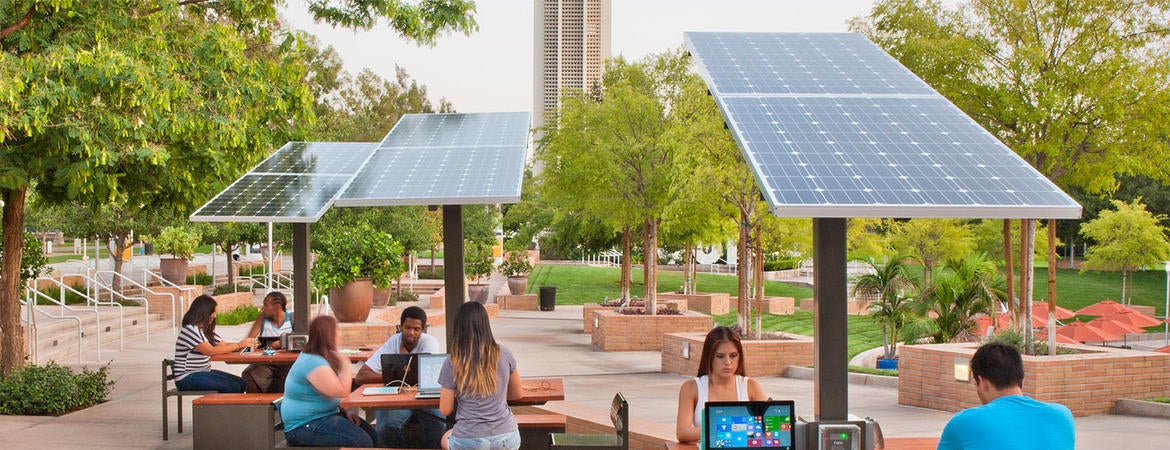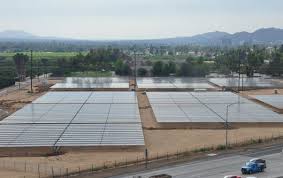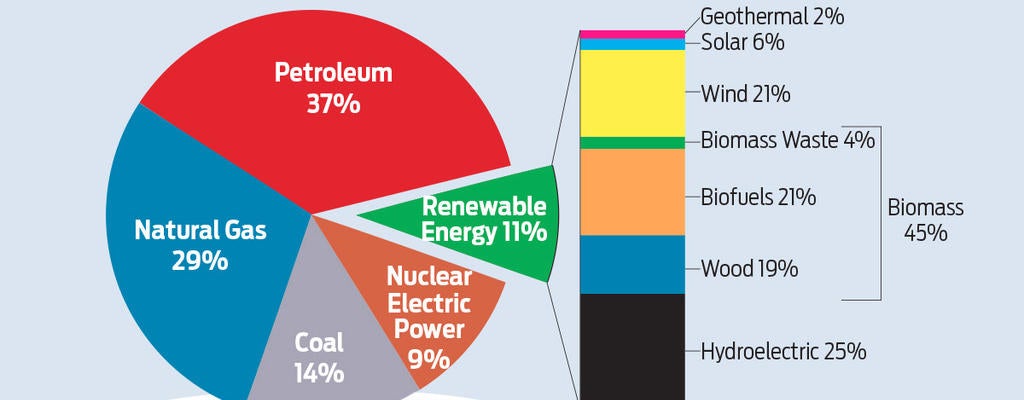Office of Sustainability

UC Riverside's Solar Farms: Steps Towards Carbon Neutrality
Have you ever heard about the UC Riverside’s solar farms?
In this blog you will be familiar with the outlines of the solar energy utilization in UC Riverside by a UCR Ph.D. student who is working on the project relevant to the solar farms.
In modern civilization energy consumption has reached an alarming level. World is faced with the problem of contamination and environment pollution including higher layers of atmosphere and the ozone layer. In such situation, looking for alternative source of energy instead of polluting energy produced by fossil fuels are highly necessary. Unlike the fossil fuels, Renewable energy sources include wind, solar, biomass, geothermal and hydro, all of which occur naturally, are clean energy and non-polluting. However, the share of renewable energies compared to the fossil fuels is
very small. The total usage of different sources of energy in 2017 in the U.S is shown below.
Among the Renewable energies, Solar power is more affordable, accessible, and prevalent. Sunlight provides by far the largest of all carbon-neutral energy sources. More energy from sunlight strikes the Earth in one hour than all the energy consumed on the planet in a year. Yet solar electricity currently provides less than 1% of total electricity supply. The huge gap between our present use of solar energy and its enormous undeveloped potential defines a grand challenge in energy research. From an economical point of view, markets for solar energy are maturing rapidly around the country, and solar electricity is now economically-competitive with conventional energy sources in several states, especially California. Since 2008, U.S. installations have grown twenty-fold.
The following chart shows the deployment of solar panels over the last decade. Now, the goal of the Solar Energy Technology Program, within the DOE Office of Energy Efficiency and Renewable Energy, are roughly achieved to make PV solar energy cost-competitive across the United States and to directly contribute to private sector to reduce carbon emissions by 40 million metric tons by 2030. Despite significant progress in reducing cost of solar panels, technological advances and innovative solutions are still needed to increase efficiency and enable utilities to rely on solar for base-load power.

Riverside is one of the most potential places for leveraging from the solar energy, which is known as the SolarCity in SoCal. In this regard, several solar farms have been constructed across Riverside and its neighborhood. UC Riverside is serious about its zero carbon footprint goal. UCR has been installing more than 9,600 solar panels in two campus parking lots, at the UC systemwide level, for on-site renewable energy, just behind UC Davis. The solar panels installed at parking lots 30 and 32,
located at the intersection of Martin Luther King Boulevard and Canyon Crest Drive, are part of UCR’s zero carbon footprint goal under the Carbon Neutrality Initiative launched by UC President Janet Napolitano four years ago. The initiative commits UC to emitting net zero greenhouse gases from its buildings and vehicle fleet by 2025.
*https://youtu.be/AItwDt4NsdA
UCR is well-known as one of the pioneer in addressing the economical and technical issues associated with integrating the solar energy into the electricity system. UCR is also home to a utility-scale electricity distribution system testbed. Recently, Smart Grid Lab at UCR has been awarded $3.2 million from the U.S. Department of Energy to improve the way customer-generated solar power is integrated onto the grid. Once developed, the new energy management system will be deployed at two power system distribution circuits in Riverside, in collaboration with Riverside Public Utilities (RPU).

As the number of homes with photovoltaic solar panels increases, so do the complexities associated with operating the aging power grid. The DOE’s Enabling Extreme Real-Time Grid Integration of Solar Energy (ENERGISE) funding program supports projects that enable the dynamic, automated and cost-effective management of distributed sources, like solar, onto the power grid. “When the power grid was set up, it was designed to handle power from conventional sources, but now we must consider the penetration of solar panels, the size and location of these units, and whether the energy they generate should go directly into the grid, get stored in batteries, or be sent somewhere else. This is a relatively new challenge and at present it is having a negative effect on grid reliability and efficiency,” said Mohsenian-Rad, who is also associate director of UCR’s Winston Chung Global Energy Center. The key goal of our research groups in Smart Grid Lab is to conduct research, development, demonstration and deployment (RD&D) activities to address the issues associated with widespread usage of clean solar energy technologies across electricity distribution grids. The Systems Integration RD&D activities require changes to be affected on both
traditional grid and PV system operations and controls. First, PV systems will need to operate interactively with conditions on the electricity grid and other local resources, including load control and generation and storage. Second, the electricity grid will need to be modified and operated in a more intelligent fashion, becoming part of a smart grid, to be more accommodating to the two-way power flow and variable generation introduced by distributed PV systems.
For more information, feel free to contact me at mfara006@ucr.edu.
